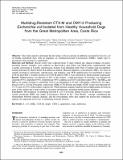| dc.contributor.author | Rodríguez-González, María José | |
| dc.contributor.author | BARQUERO-CALVO, ELIAS | |
| dc.contributor.author | Jiménez-Pearson, María Antonieta | |
| dc.contributor.author | Duarte, Francisco | |
| dc.contributor.author | Poklepovich Caride, Tomas Javier | |
| dc.contributor.author | Campos, Josefina | |
| dc.contributor.author | Araya-Sánchez, Luis Nazario | |
| dc.contributor.author | Chirino-Trejo, Manuel | |
| dc.date.accessioned | 2020-11-05T22:16:35Z | |
| dc.date.available | 2020-11-05T22:16:35Z | |
| dc.date.issued | 2020 | |
| dc.identifier.uri | http://hdl.handle.net/11056/18570 | |
| dc.description.abstract | Objective:This study aimed to determine the prevalence of fecal carriage of antibiotic-resistantEscherichia coliof healthy household dogs with an emphasis on extended-spectrumb-lactamases (ESBL), AmpC-typeb-lactamases and resistance to quinolones.Materials and Methods:Rectal swabs were collected from 74 dogs without any clinical evidence of gastro-intestinal disease. Samples were cultured on MacConkey agar plates and MacConkey supplemented with2mg/mL cefotaxime or 5mg/mL ciprofloxacin. Isolates were identified with Vitek 2 Compact and susceptibilitytesting performed by Kirby Bauer disk diffusion method. Minimal inhibitory concentration ( MIC) was done onisolates resistant to cefotaxime, ciprofloxacin, and nalidixic acid. PCR amplification was performed to detectCTX-M and CMY-2. Isolates positive for CTX-M and/or CMY-2 were selected for whole-genome sequencing.Results:Multiresistance was detected in 56% of the isolates. A high percentage of resistance was detected forcefazolin (63%), ampicillin (54%), streptomycin (49%), nalidixic acid (42%) and tetracycline (38%). The MIC50andMIC90for isolates resistant to cefotaxime (24%) was determined as 16 and>250mg/mL, respectively; for cipro-floxacin (18%), 125 and 250mg/mL, respectively. ESBL (CTX-M type) and AmpC (CMY-2 type) were detected in 6(7.1%) and 14 (19%) of the isolates, respectively. Whole-genome sequence analysis showed high genetic diversity inmost of the isolates and a large variety of resistance mechanisms, including mobile genetic elements.Conclusion:The frequency of multidrug-resistantE. coliis worrying, mainly because of the presence of manyisolates producing ESBL and AmpCb-lactamases. Based on the ‘‘One Health’’ concept, considering therelationships between animals, humans, and the environment, these data support the notion that companionanimals are important reservoirs of multidrug-resistant bacteria | es_ES |
| dc.description.abstract | Objetivo: El objetivo de este estudio era determinar la prevalencia del transporte fecal de Escherichia coli resistente a los antibióticos en perros domésticos sanos, haciendo hincapié en las blactamasas de espectro ampliado (ESBL), las blactamasas de tipo AmpC y la resistencia a las quinolonas. Materiales y métodos: Se recogieron hisopos rectales de 74 perros sin ninguna evidencia clínica de enfermedad gastrointestinal. Las muestras se cultivaron en placas de agar MacConkey y MacConkey se complementó con 2mg/mL de cefotaxima o 5mg/mL ciprofloxacin. Los aislamientos fueron identified con Vitek 2 Compact y las pruebas de susceptibilidad realizadas por el método de difusión en disco de Kirby Bauer. Se realizó una concentración inhibitoria mínima (CIM) en aislamientos resistentes a la cefotaxima, ciprofloxacin, y al ácido nalidíxico. Se realizó la PCR amplification para detectar CTX-M y CMY-2. Se seleccionaron los aislados positivos para CTX-M y/o CMY-2 para la secuenciación del genoma completo. Resultados: Se detectó multirresistencia en el 56% de los aislados. Se detectó un alto porcentaje de resistencia para cefazolina (63%), ampicilina (54%), estreptomicina (49%), ácido nalidíxico (42%) y tetraciclina (38%). Se determinó que la MIC50 y la MIC90 para las cepas resistentes a la cefotaxima (24%) eran 16 y >250mg/mL, respectivamente; para ciprofloxacin(18%), 125 y 250mg/mL, respectivamente.se detectaron ESBL (tipo CTX-M) y AmpC (tipo CMY-2) en 6 (7,1%) y 14 (19%) de las cepas, respectivamente. El análisis de la secuencia del genoma completo mostró una alta diversidad genética en la mayoría de los aislados y una gran variedad de mecanismos de resistencia, incluidos elementos genéticos móviles. Conclusión: La frecuencia de E. coli multirresistente a las drogas es preocupante, principalmente debido a la presencia de muchos aislados que producen ESBL y AmpC blactamasas. Basándose en el concepto de ''Una Salud'', considerando las relaciones entre los animales, los seres humanos y el medio ambiente, estos datos apoyan la noción de que los animales de compañía son importantes reservorios de bacterias multirresistentes. | es_ES |
| dc.description.sponsorship | Universidad Nacional, Costa Rica | es_ES |
| dc.language.iso | eng | es_ES |
| dc.publisher | Mary Ann Liebert, Inc. | es_ES |
| dc.rights | Acceso abierto | es_ES |
| dc.rights.uri | http://creativecommons.org/licenses/by-nc-sa/4.0/ | * |
| dc.source | MICROBIAL DRUG RESISTANCE Vol. 26, No. 11, 2020 | es_ES |
| dc.subject | DOG | es_ES |
| dc.subject | PERRO | es_ES |
| dc.subject | ESCHERICHIA COLI | es_ES |
| dc.subject | ANTIBIÓTICOS | es_ES |
| dc.subject | ANTIBIOTICS | es_ES |
| dc.title | Multidrug-Resistant CTX-M and CMY-2 producing Escherichia coli Isolated from healthy household dogs from the great metropolitan area, Costa Rica | es_ES |
| dc.type | http://purl.org/coar/resource_type/c_6501 | es_ES |
| dc.description.procedence | Escuela de Medicina Veterinaria | es_ES |
| dc.identifier.doi | 10.1089/mdr.2020.0146 | |


